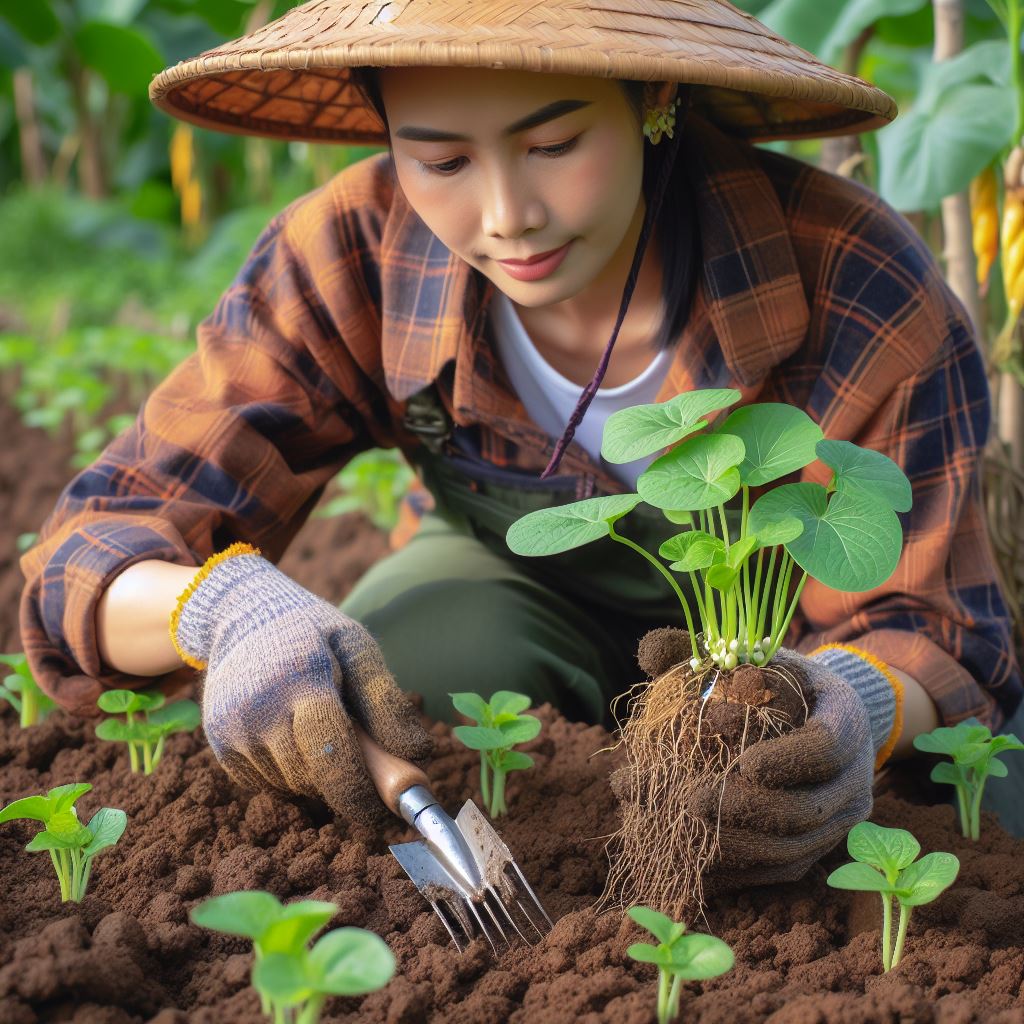Introduction
Seasonal planting is essential, as outlined in the seasonal planting guide for year-round yield.
In this article, we will explore the importance of seasonal planting and provide a brief overview of the content that will be covered.
Importance of Seasonal Planting for Year-Round Yield
Seasonal planting plays a crucial role in maximizing the productivity of your garden throughout the year.
By understanding which plants thrive in specific seasons, you can cultivate a continuous harvest, ensuring a steady supply of fresh produce.
Planting the right crops at the right time allows you to take advantage of the natural climate and environmental conditions.
This enables your plants to flourish and produce higher yields.
Factors such as temperature, daylight hours, and soil conditions greatly influence the growth and development of plants.
By following a seasonal planting guide, you can effectively plan and schedule your garden activities.
This knowledge allows you to make informed decisions about when to sow seeds, transplant seedlings, and harvest crops.
It helps you optimize your space and resources, ultimately leading to a more successful and abundant harvest.
Brief Overview of Article’s Content
In this article, we will first delve into the importance of understanding your local climate and its impact on plant growth.
Next, we will explore the different seasons and discuss which crops are best suited for each.
We will provide insights on planting techniques, pest control, and maintaining optimal soil conditions.
Additionally, we will offer tips on extending the growing season, including the use of greenhouses, row covers, and cold frames.
Finally, we will touch upon the benefits of crop rotation and intercropping as sustainable practices that promote soil health and disease prevention.
By the end of this article, you will have a comprehensive understanding of seasonal planting and be equipped with the knowledge to successfully achieve year-round yield in your garden.
Stay tuned for the upcoming sections, where we will dive deeper into each season and provide practical advice for cultivating a bountiful harvest.
Spring Planting Guide
Types of crops suitable for spring planting
- Vegetables
- Herbs
- Flowers
Ideal planting dates for different crops
Each crop has its specific planting date, which ensures optimal growth and good yields:
Vegetables
- Tomatoes: Plant after the last frost, once the soil has warmed up.
- Peppers: Start indoors and transplant after the risk of frost has passed.
- Lettuce: Sow seeds directly in the ground four weeks before the last frost date.
Herbs
- Basil: Plant after the last frost in well-drained soil with plenty of sunlight.
- Mint: Start indoors and transplant after the danger of frost is over.
- Dill: Sow seeds directly in the garden once the soil is workable.
Flowers
- Pansies: Plant six to eight weeks before the last frost for early spring blooming.
- Zinnias: Sow seeds directly in the garden after the last frost date.
- Marigolds: Start indoors six to eight weeks before the last frost and transplant outside.
Tips for soil preparation and plant care during spring
Proper soil preparation and plant care are essential for a successful spring planting:
- Clear the area: Remove any weeds, old plants, and debris from the garden bed.
- Test the soil: Check the soil pH and nutrient levels to determine if any amendments are necessary.
- Add organic matter: Incorporate compost or well-rotted manure to improve soil structure and fertility.
- Prepare the planting holes: Dig proper-sized holes for each plant, leaving enough space between them.
- Water adequately: Provide plants with enough water, especially during dry periods.
- Mulch the beds: Apply a layer of mulch around plants to conserve moisture, suppress weeds, and regulate soil temperature.
- Protect from pests: Use organic pest control methods like companion planting or row covers.
- Monitor plant health: Keep an eye out for signs of disease or nutrient deficiencies and take appropriate action.
- Harvest regularly: Harvest vegetables and herbs promptly to encourage continuous growth and productivity.
By following these guidelines, you can maximize your spring planting efforts and enjoy a bountiful yield of fresh produce and vibrant flowers.
Read: Maximize Yields, Minimize Water in Urban Farms
Summer Planting Guide
Crops best suited for summer planting
- Fruits
- Greens
- Heat-tolerant vegetables.
Recommended planting dates for summer crops
When it comes to summer planting, timing is everything.
Here are the recommended planting dates for various crops:
- Tomatoes: Start planting after the danger of frost has passed, usually in late spring.
- Cucumbers: Plant seeds or seedlings once the soil temperature reaches 60°F or above.
- Peppers: Wait until the soil has warmed up to at least 70°F for optimal growth.
- Squash: Plant seeds directly in the garden when all frost danger has passed.
- Beans: Sow seeds directly in the soil once the temperature consistently stays above 50°F.
Watering and pest control strategies for summer plants
Keeping your summer plants hydrated and protected from pests is crucial for a successful yield. Here are some strategies to follow:
- Watering: Provide regular, deep watering to prevent drought stress. Aim for about 1-2 inches of water per week.
- Drip irrigation: Consider using drip irrigation to ensure efficient water delivery directly to the roots.
- Mulching: Apply a layer of mulch around your plants to help retain soil moisture and prevent weed growth.
- Companion planting: Use companion plants to naturally deter pests. For example, planting marigolds near tomatoes can repel nematodes.
- Organic pest control: Practice organic pest control methods, such as handpicking pests or using insecticidal soaps or neem oil.
- Netting or fencing: Install netting or fencing to protect your fruits and vegetables from birds, squirrels, and other critters.
By following this summer planting guide, you can maximize your yield and enjoy a bountiful harvest throughout the season.
Happy planting!
Read: Eco-Friendly Farming: Water Conservation Tricks
Transform Your Agribusiness
Unlock your farm's potential with expert advice tailored to your needs. Get actionable steps that drive real results.
Get StartedFall Planting Guide
Cool season crops that thrive in the fall
- Arugula – plant arugula in the fall for a spicy and flavorful addition to salads.
- Broccoli – broccoli loves the cooler temperatures of fall and produces tasty heads.
- Cabbage – fall is the perfect time to plant cabbage, which can be enjoyed raw or cooked.
- Carrots – plant carrots in the fall for a sweet and crunchy harvest later in the season.
- Kale – kale thrives in cooler weather and can be harvested throughout the fall.
- Lettuce – varieties like romaine and leaf lettuce do well in the fall and can be harvested multiple times.
- Spinach – spinach is a hardy green that can withstand cooler temperatures and provide a nutritious harvest.
Optimal timing for planting fall crops
- Timing is crucial when planting fall crops, as they need enough time to mature before frost.
- Check the average first frost date in your area and count back from there to determine planting dates.
- Start planting cool-season crops in late summer or early fall, typically around 6-8 weeks before the first frost.
- Some crops, like lettuce and spinach, can be succession planted throughout the fall for a continuous harvest.
Protecting plants from frost and cold weather during fall
- Mulch around your fall crops to help insulate the soil and protect the plants’ roots from frost.
- Use row covers or cloches to create a mini greenhouse effect and shield plants from cold winds.
- Water the plants thoroughly before a frost to help protect them from freezing temperatures.
- If a frost is predicted, cover plants overnight with blankets or sheets to provide additional insulation.
- Remove the covers during the day to allow the plants to receive sunlight and prevent overheating.
By following this fall planting guide, you can enjoy a bountiful harvest even as the weather cools down.
Read: Attracting Beneficial Insects to Gardens

Winter Planting Guide
Winter planting can be a rewarding experience, allowing gardeners to continue enjoying fresh produce throughout the colder months.
While the selection of crops may be more limited compared to other seasons, there are still plenty of cold-hardy options to choose from.
Cold-hardy crops suitable for winter planting
1. Kale
Kale is an excellent winter vegetable as it thrives in cooler temperatures and can withstand frost.
Varieties such as Winterbor and Lacinato (also known as dinosaur kale) are especially cold-hardy.
2. Spinach
Spinach is another winter favorite, known for its ability to handle chilly weather.
Varieties like Bloomsdale and Space are great choices for winter gardens.
3. Swiss chard
Swiss chard can tolerate cold temperatures and continue to produce vibrant, nutritious leaves throughout the winter.
Bright Lights and Ruby varieties offer beautiful color variation.
4. Arugula
Arugula is a quick-growing green that can be sown directly in the garden or in containers during winter.
Its peppery flavor adds a fresh touch to winter salads.
5. Brussels sprouts
Brussels sprouts are a popular winter crop, known for their iconic miniature cabbages.
They require a longer growing period, so it’s best to start them in late summer for winter harvest.
Techniques for extending the growing season
1. Use row covers to protect plants from frost
Row covers are lightweight fabric materials that can be draped over plants to create a barrier against frost.
They allow sunlight, air, and water to reach the plants while providing insulation.
2. Build a hoop house or greenhouse to provide extra warmth
Hoop houses or greenhouses are excellent options for creating a controlled environment for winter gardening.
They trap heat and protect plants from harsh weather conditions.
3. Use mulch to insulate the soil and retain heat
Adding a layer of mulch around plants helps to regulate soil temperature and conserve moisture.
Organic materials like straw or shredded leaves work well as insulating mulch.
4. Plant in raised beds to improve drainage and heat absorption
Raised beds offer better drainage than traditional garden beds, which can be crucial during winter when excess water can lead to root rot.
The elevated soil also warms up faster in sunlight.
5. Install a frost-protection system, such as sprinklers or heaters
In areas prone to severe freezes, installing sprinklers or heaters can help raise the temperature and prevent frost damage.
These systems should be used when temperatures drop below freezing.
Managing potential winter pests and diseases
1. Monitor plants regularly for signs of pests or diseases
Regularly inspecting plants allows you to catch any pest or disease problems early on.
Look for chewed leaves, discolored spots, or wilting as signs of potential issues.
2. Remove any infected or damaged plant material promptly
If you spot any signs of pests or diseases, promptly remove the affected plant parts to prevent the issue from spreading.
Dispose of the infected material away from the garden.
3. Maintain good airflow in the garden to prevent fungal diseases
Fungal diseases thrive in damp, still air.
Prune back any overcrowded plants and ensure there is sufficient space between plants to promote airflow.
4. Use organic pest control methods, such as neem oil or insecticidal soap
If pests become a problem, opt for organic pest control methods.
Neem oil, insecticidal soap, and handpicking insects can effectively manage pests without harming beneficial insects.
5. Consider companion planting to deter pests, such as planting marigolds to repel aphids
Companion planting involves pairing plants that benefit each other.
Certain flowers, like marigolds, can repel pests such as aphids and act as a natural pest deterrent in the garden.
By following these tips and selecting suitable winter crops, you can extend your growing season and enjoy fresh produce even during the colder months.
Happy winter gardening!
Read: Using Essential Oils Against Pests
Tips for Year-Round Planting Success
Crop rotation and succession planting guidelines
- Rotate crops annually to prevent soil depletion and reduce the risk of pests and diseases.
- Plan your planting schedule to ensure a continuous harvest by staggering plantings at regular intervals.
- Group crops with similar growing requirements together to optimize space and resources.
Utilizing greenhouses and hoop houses
- Invest in a greenhouse or hoop house to extend your growing season and protect crops from extreme weather conditions.
- Control temperature and humidity levels inside the structures to create an ideal environment for plant growth.
- Utilize vertical space by incorporating trellises and hanging baskets to maximize your planting area.
Soil amendment recommendations for continuous fertility
- Test your soil regularly to determine its nutrient composition and pH level.
- Amend the soil with organic matter such as compost, manure, or cover crops to improve its fertility.
- Use natural fertilizers, like fish emulsion or seaweed extract, to provide essential nutrients to your plants.
By implementing these tips, you can achieve year-round planting success and maximize your garden’s yield.
Explore Further: Indoor Herb Magic: Grow Basil, Mint & More
Conclusion
Recap of the seasonal planting guide
Spring calls for carrots and peas, while summer thrives with tomatoes and peppers.
In fall, lettuce and spinach take center stage, and winter welcomes kale and broccoli.
Remember to rotate your crops and enrich the soil for optimal yield.
Encouragement for readers to experiment with year-round gardening
Don’t hesitate to explore new varieties and techniques.
Embrace the challenges of year-round gardening as they foster resilience and offer continuous rewards of fresh produce.
Let your garden be a canvas for creativity and innovation.
Showcase Your Farming Business
Publish your professional farming services profile on our blog for a one-time fee of $200 and reach a dedicated audience of farmers and agribusiness owners.
Publish Your ProfileClosing remarks and invitation for feedback or questions
Thank you for embarking on this gardening journey with us.
Your experiences and insights are valuable.
Feel free to share your successes and challenges.
Together, let’s cultivate a community of passionate gardeners dedicated to sustainable and fulfilling year-round gardening.
Your feedback is instrumental in shaping future discussions and content.
Don’t hesitate to reach out with any questions or suggestions.
Happy planting, and may your gardens flourish abundantly throughout the seasons.




